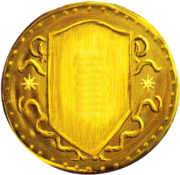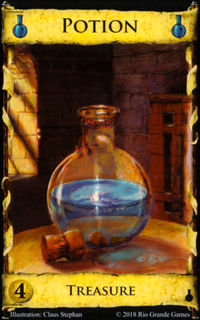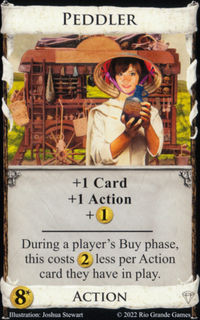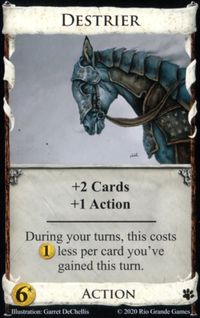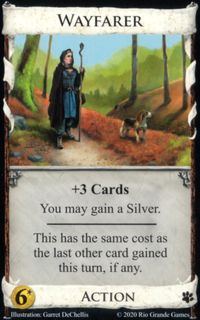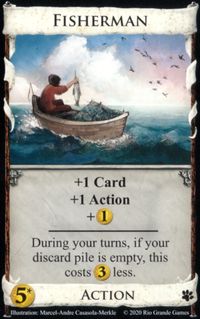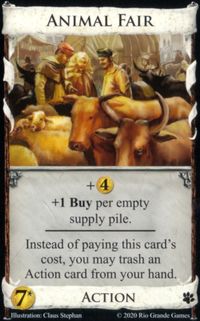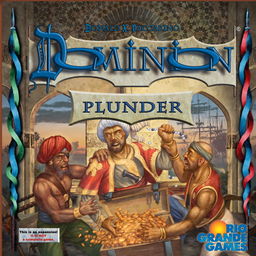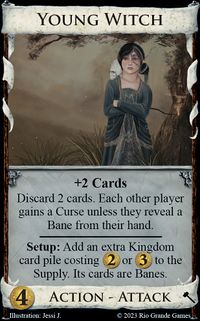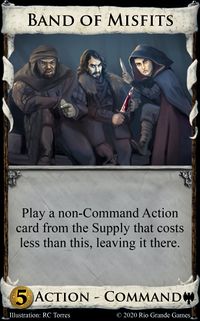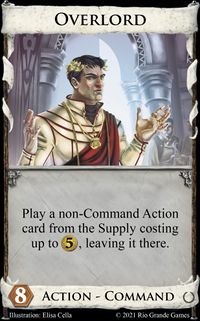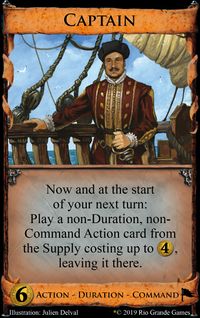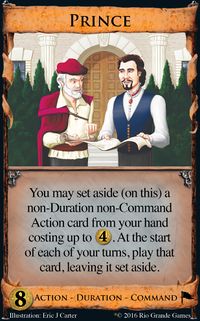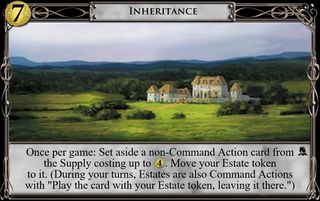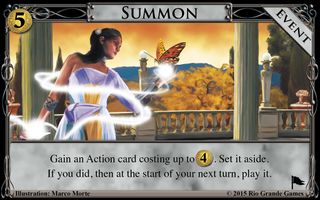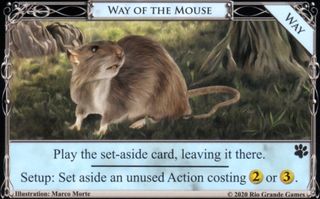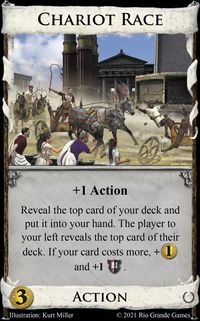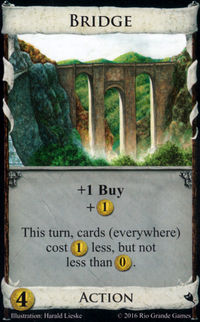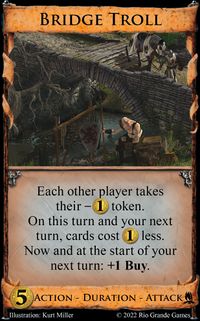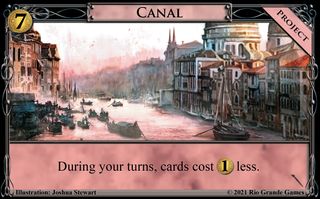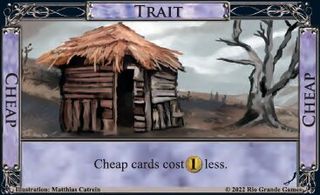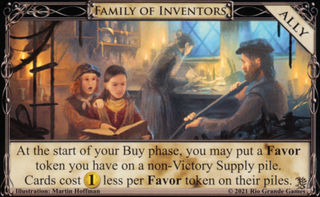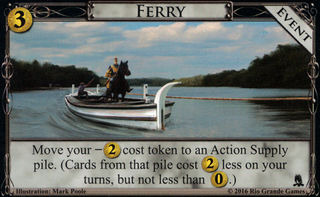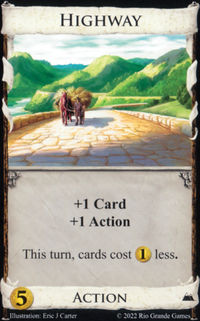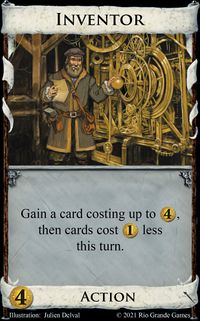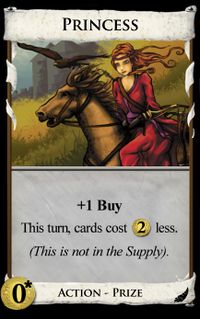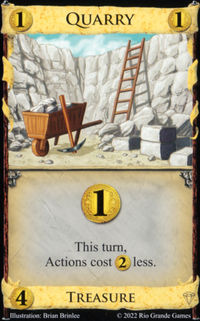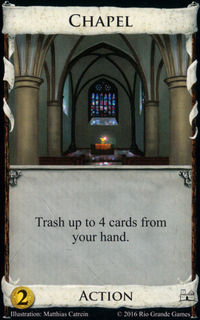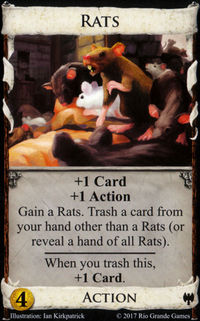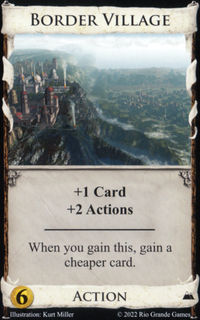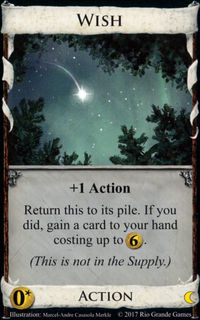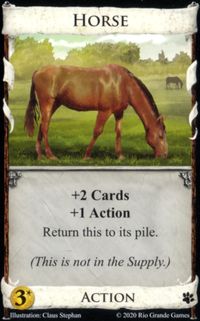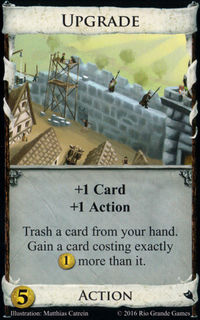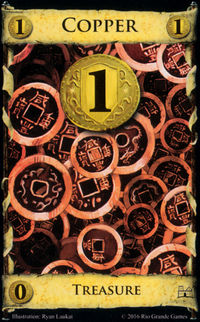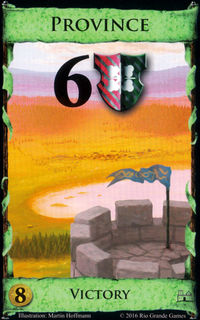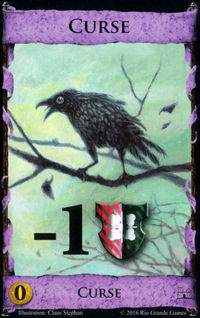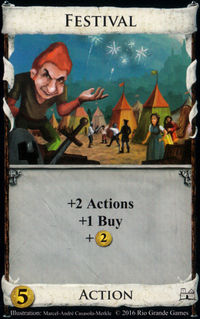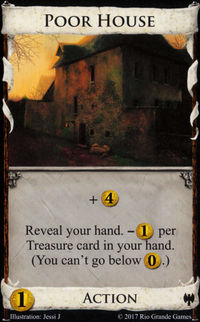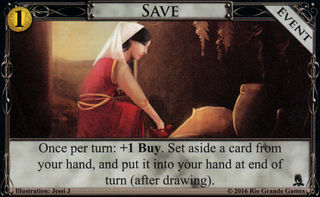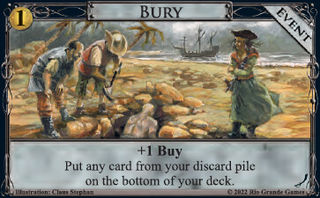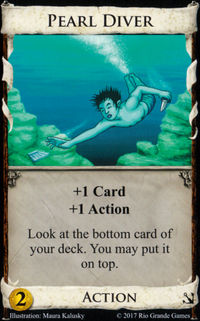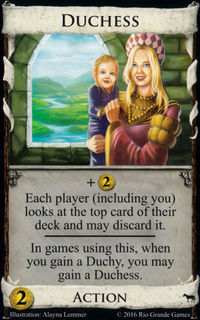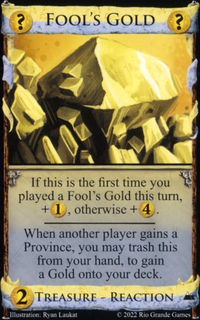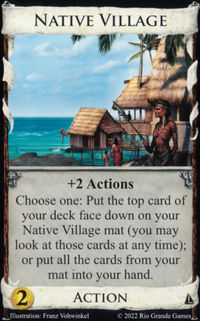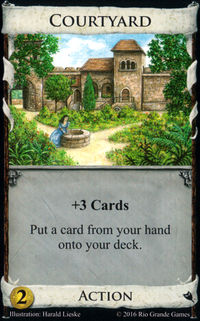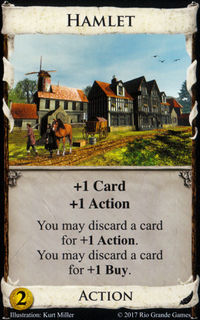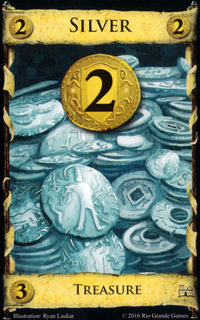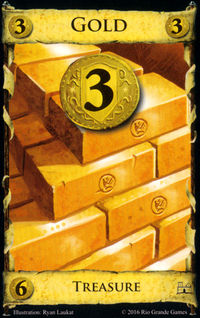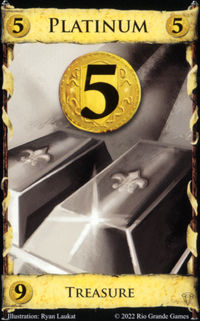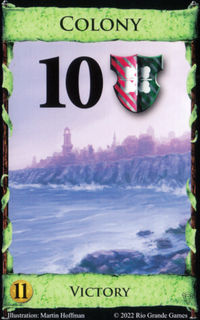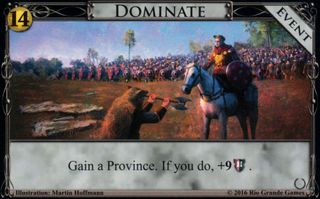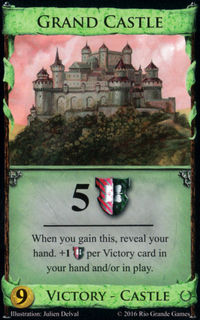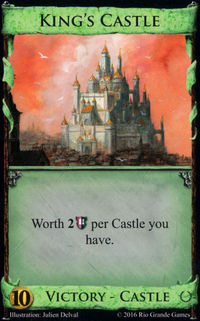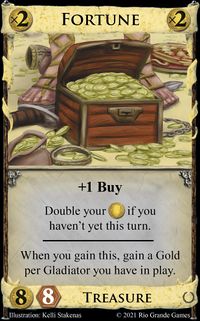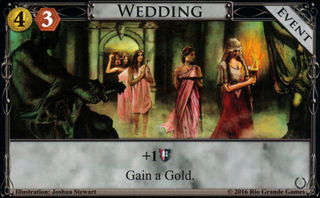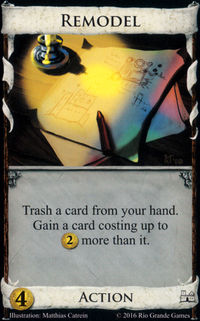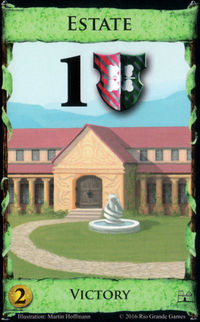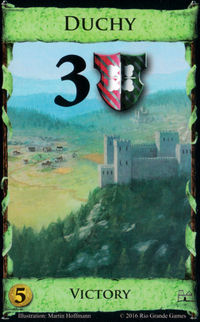Cost

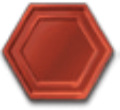
The cost of a card, Event or Project is the amount that must be paid in order to buy it. A card's cost is indicated in its lower left corner, and an Event or Project's cost is indicated in its upper left corner. Every card, Event or Project costs some number of , , and . Only relevant cost components are shown, the rest are omitted. If something does not cost any resources (besides a Buy), is shown. To buy something, a player must have the requisite number of and unspent, a Buy, and no .
Contents |
[edit] Symbols in costs
Most cards include Coins in their cost, symbolized . To buy a card with in the cost, you must have made enough during your turn. The primary way of making is by playing Action and Treasure cards. Coffers and some Events, Artifacts, Boons, Allies, and Night cards provide additional ways to make .
Some cards in Alchemy include Potion in their cost, symbolized . This may be in addition to some number of . The and components of costs are orthogonal; is not greater than, less than, or equal to . To buy a card with in the cost, you must have played a Potion, in addition to having made enough to pay for the portion of the card's cost.
Some cards in Empires include Debt in their cost, symbolized . This may be in addition to some number of . The and components of costs are orthogonal; is not greater than, less than, or equal to . Unlike and , players do not pay when buying cards costing ; instead they take tokens when buying cards costing . is paid off by .
Some cards in Guilds include a superscript plus sign in their cost (e.g., ). This indicates the card may be overpaid for.
Some cards include an asterisk in their cost (e.g., ). This indicates there is something unusual about the card's cost. Cards from non-Supply piles have asterisks in their costs to remind players that, despite having a cost, they cannot be bought. Peddler, Destrier, Wayfarer, and Fisherman have asterisks to remind players that they have effects that change their cost, and Animal Fair has an asterisk to remind players that there's an alternative way to buy it other than by paying its cost. Cards with asterisks can be found in Prosperity, Cornucopia, Dark Ages, Adventures, Nocturne, Menagerie, and Plunder.
Asterisks and plus signs are only reminders; unless otherwise specified, a card still has its normal cost for all purposes described below.
[edit] Comparing costs
Many effects cause players to compare the cost of a card to another card, or a fixed value. These commonly include effects from gainers, remodelers, and trashing attacks. An amount of two cost components ( and , or and ) is only larger than another if both cost component amounts are larger, or one is larger and one the same.
For example:
- costs more than .
- Any card with or in its cost does not cost up to .
- Any card with or in its cost does not cost from to .
- costs more than , but does not.
- is not more than , and is not more than ; both have something the other lacks.
- Things that change costs only change the cost; and are unaffected by changes in .
[edit] Purposes of costs
The primary purpose of a card's cost is to indicate the resources needed to buy it. However, many things make references to a card's cost at other times. For example:
- Most gainers and several trashing attacks can only gain or trash cards with specified costs.
- Most trash-for-benefit cards have effects that depend on the cost of the trashed card.
- Only cards with certain costs may be Young Witch's bane.
- Only cards with certain costs may be commanded by Band of Misfits, Overlord, or Captain, or be set aside by Prince, Inheritance, Summon, or Way of the Mouse.
- The effect of the card Chariot Race depends on comparing the costs of two other cards.
For this reason, all cards have costs, even those that it is never possible to buy, such as Shelters and Heirlooms.
[edit] Changes in cost
Some things have effects that temporarily or permanently change the cost of some or all cards: Bridge, Bridge Troll, Canal, Cheap, Destrier, Family of Inventors, Ferry, Fisherman, Highway, Inventor, Peddler, Princess, Quarry and Wayfarer. When these effects occur, the affected costs are changed for all purposes (see above). These abilities change the costs of cards, but not of Events or Projects.
[edit] Strategy
In general, more "powerful" cards, Events and Projects have higher costs, but overall power is not the only consideration that goes into determining cost. For example:
- Chapel is often cited as a card whose strength is considered disproportionate to its low cost of .
- Costs between and are influenced by how useful the card, Event, or Project is as an opening, and how desirable or necessary it is to be able to accumulate multiple copies of a card with extra Buys.
- Cards with beneficial on-gain or on-buy effects typically cost more than their on-play effect would seem to require.
- Some cards' costs differ from what their power levels might suggest in order to interact better with other cards. Rats costs to interact favorably with trash-for-benefit cards, while Border Village costs to give you a wider range of other cards to gain with its when-gain ability.
- Some strong non-Supply cards, such as Wish and Rewards, cost in order to remind the player that they cannot be bought, and to make them less appealing targets for trash-for-benefit effects. However, other non-Supply cards, such as Loot and Horses, do have costs roughly commensurate with their power level.
In general, a card will never be strictly better than a similar card with the same or a higher cost.
Most Kingdom cards cost between and . There are only eleven Kingdom piles with cards costing more than and one Kingdom card costing less than . This means most games of Dominion do not have Supply cards costing or . These gaps can influence gameplay in subtle but substantial ways. For examples, Upgrade can trash Copper without gaining anything, and cannot trash anything to gain a Province. In the rare games when cards costing or are in the Supply, the utility of a card like Upgrade can change dramatically.
[edit] 0 cost
Cards that cost are either meant to be so terrible that they're essentially free (e.g., Copper, Curse, and Ruins), or are non-Supply cards that are meant to be quite powerful. In the latter case, a zero cost helps indicate that these are not normal cards, and discourages any other use for them than playing them (such as remodeling them).
Events that cost are meant to be always available, and come with some penalty or restriction to prevent their abuse.
Cards and Events that cost still require an available Buy, whether the single Buy available each turn or given by a card such as Festival, in order to buy them.
[edit] 1 cost
Cards that cost do so mainly as a gimmick: Poor House has this cost for flavor reasons, and to change early game playstyles.
Save and Bury, the Events that cost , have a relatively minor effects that are intended to be almost always available.
[edit] 2 cost
is the lowest normal cost for Kingdom cards. Cards that cost are priced so players can always open with them, and can easily pick up extra copies of them with spare Buys. These include:
- Cards whose effects are usually relatively weak or inconsequential (e.g., Pearl Diver and Duchess).
- Cards that are strong only in multiples (e.g., Fool's Gold and Native Village). These cards are cheap to enable you to easily buy enough of them to make them worthwhile.
- Cards that are less strong in multiples (e.g., Courtyard or Hamlet). The low price does not make these cards overpowering because, although you can buy several copies of them, they have diminishing returns; you don't get that much benefit from having many copies of them. Chapel epitomizes this: it's often described as the strongest card in the game relative to its cost, but rarely does anyone need more than one copy of it.
The Events mostly give +Buy and a small but useful bonus, offering another use for extra the player may have in their Buy phase.
There are no Projects as it would be too automatic to pick one up with an extra +Buy.
[edit] 3 cost
Cards and Events that cost are priced so that players can open with two of them, but cannot (usually) open with one of them and a card costing . They are typically more powerful than cards and Events. Cards, Events and Projects at this cost also directly compete with Silver.
[edit] 4 cost
Cards, Events and Projects that cost are priced so that players can usually open with one of them, but cannot (usually) open with more than one of them. cards are often relatively powerful early-game Attacks or trashers.
[edit] 5 cost
is considered to be the most important cost in Dominion, and it is the cost with the most cards, Events and Projects. Most cards at this cost are considered quite powerful; if a player gets to open with a card costing , their other opening card must be or less. The difference in power between a typical card costing and a card costing is substantially wider than between cards costing and cards costing . Therefore, making is an important part of early game strategy; players must often choose between early trashing, or buying things that will help them make . Most cursers and many powerful terminal draw cards cost .
[edit] 6 cost
Cards, Events and Projects that cost directly compete with Gold. They tend to be exceptionally powerful, and players usually cannot open with them.
[edit] 7 cost
Cards, Events and Projects that cost still compete with Gold, but the extra in cost means these few cards, Events and Projects are just that much harder to acquire. Cards costing can be seen as a consolation prizes for not making , but they also allow remodelers that gain cards costing "exactly more than" a trashed card to gain Provinces.
[edit] 8 cost
Cards, Events, and Projects that cost directly compete with Province; a player chooses to buy these cards, Events or Projects instead of a Province. Peddler, while nominally costing , is rarely purchased for more than .
[edit] 9 and higher cost
Platinum at and Colony at have the most expensive costs of card piles in the game, and Dominate at is the most expensive Event in the game. The two most expensive Castles (Grand Castle at and King's Castle at ) also fall into this price range, and all the cards and Events in this category can be extremely powerful. Games with these high-costing cards usually last longer as players build their decks up to make enough to buy them.
[edit] Potion cost
Since the only way to buy a card with in the cost is the relatively inflexible Potion card, such cards are generally more inconvenient to acquire than comparable cards with costs. To motivate players to go to the trouble, these cards are typically powerful and reward accumulating multiple copies of them.
[edit] Debt cost
Debt allows players to pay some or all of a card or Event's cost at a later time. Cards and Events with solely in their cost can be bought at any time, provided the player does not already have . Thus, while they may be expensive, they can be bought on a player's opening turns, though this may mean that they can't buy anything else for the next turn or turns. As such, cards and Events with no other cost tend to have some feature or penalty that makes them not worth buying in the first few turns.
One card (Fortune) and one Event (Wedding) have both a cost and a cost; the same concepts from the purely -costing cards and Events apply, but now these two have an additional threshold that must be met as well, rather than being able to buy them at any time.
[edit] Trivia
[edit] Donald X.'s thoughts
Obv. some cards care about their own cost specifically, e.g. Band of Misfits, or have a weird cost thing e.g. Peddler. And all Remodels have built in the possibility of Remodel-ing them. I think those are the main cases - refer to cost of itself, refer to cost of cards in general. Being the bottom of a split pile does have the possibility of making a difference.
Cards try not to be too similar to other cards, but sometimes something similar seems worthwhile, and then it's an issue, it can't be strictly better than another card. This may cause it to do more/less so it can have a different cost. Or kill it.
Sometimes there's a good reason for a card to be cheap or a or expensive - a reactive card wants to be cheap, an early-game card prefers to cost less than , a slow (but somehow worthwhile) card wants to cost more. But here the card itself is tweaked to get something that's good at the good cost.Some statistics on costs (as of November 2018):
| Cost | Kingdom Card Piles | Differently-named Cards | Kingdom Card Piles (2E only) | Differently-named Cards (2E only) | Events | Projects | Non-Kingdom Supply Piles |
|---|---|---|---|---|---|---|---|
| 334 | 405 | 322 | 393 | 34 | 20 | 11 | |
| 19 (4.7%) | 19 (4.8%) | 4 (11.8%) | 3 (Copper, Curse, Ruins) | ||||
| 1 (0.3%) | 4 (1.0%) | 1 (0.3%) | 4 (1.0%) | 1 (2.9%) | |||
| 39 (11.7%) | 45 (11.1%) | 38 (11.8%) | 44 (11.2%) | 4 (11.8%) | 1 (Estate) | ||
| 58 (17.4%) | 64 (15.8%) | 55 (17.1%) | 61 (15.5%) | 5 (14.7%) | 5 (25.0%) | 1 (Silver) | |
| 90 (26.9%) | 99 (24.4%) | 85 (26.4%) | 94 (23.9%) | 4 (11.8%) | 4 (20.0%) | 1 (Potion) | |
| 112 (33.5%) | 128 (31.6%) | 110 (34.2%) | 126 (32.1%) | 6 (17.6%) | 6 (30.0%) | 1 (Duchy) | |
| 14 (4.2%) | 18 (4.4%) | 13 (4.0%) | 17 (4.3%) | 3 (8.8%) | 3 (15.0%) | 1 (Gold) | |
| 4 (1.2%) | 5 (1.2%) | 4 (1.2%) | 5 (1.3%) | 1 (2.9%) | 1 (5.0%) | ||
| 2 (0.6%) | 4 (1.0%) | 2 (0.6%) | 4 (1.0%) | 1 (2.9%) | 1 (5.0%) | 1 (Province) | |
| 2 (0.5%) | 2 (0.5%) | 1 (Platinum) | |||||
| 1 (0.2%) | 1 (0.3%) | ||||||
| 1 (0.2%) | 1 (0.3%) | 1 (Colony) | |||||
| 1 (2.9%) | |||||||
| Includes | 10 (3.0%) | 10 (2.5%) | 10 (3.1%) | 10 (2.5%) | |||
| Includes | 4 (1.2%) | 5 (1.2%) | 4 (1.2%) | 5 (1.3%) | 5 (11.8%) |
